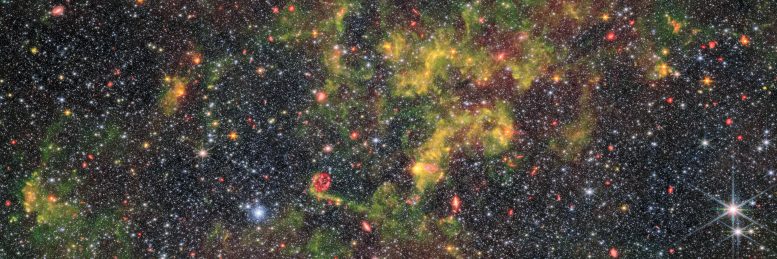
This James Webb Space Telescope observation of the irregular, low-metallicity galaxy NGC 6822 offers valuable insights into early Universe processes like stellar evolution and interstellar dust life cycle. Initially discovered by E. E. Barnard in 1884, NGC 6822 was later studied by Edwin Hubble, who identified it as the first object located outside the Milky Way. The investigation of this galaxy continues today with the James Webb Space Telescope. Credit: ESA
Observing Irregular Galaxy NGC 6822 With James Webb Space Telescope
Captured by the Near-InfraRed Camera (NIRCam) and Mid-InfraRed Instrument (MIRI) mounted on the James Webb Space Telescope, this image shows the irregular galaxy NGC 6822. As their names suggest, NIRCam and MIRI probe different parts of the electromagnetic spectrum. This allows the instruments to observe different components of the same galaxy, with MIRI especially sensitive to its gas-rich regions (the yellow swirls in this image) and NIRCam suitable for observing its densely packed field of stars.
NGC 6822: A Glimpse into the Early Universe
Located approximately 1.5 million light-years away, NGC 6822 is the nearest galactic neighbor to the Milky Way that is not a satellite.
It exhibits very low metallicity, meaning it has minimal proportions of elements other than hydrogen and helium. Metallicity is a fundamental concept in astronomy since elements apart from hydrogen and helium are predominantly produced by stars over their lifetimes.
In the early universe, before the first generation of stars had been born, lived, and died, everything was of low metallicity. Hence, modern objects with low metallicity, like NGC 6822, are valuable in understanding how processes such as stellar evolution and the life cycle of interstellar dust likely occurred in the early Universe.
These considerations motivated the observations of NGC 6822 with Webb to better comprehend the formation of stars and the evolution of dust in low-metallicity environments.
The Historical Study of NGC 6822
The study of NGC 6822 has an interesting history that long predates modern investigations with Webb. It was first discovered by E. E. Barnard, who presented his discovery in a very brief paper in 1884 in The Sidereal Messenger: a short-lived but important American monthly astronomical journal that was published between 1882 and 1891. As with many astronomical objects that appeared diffuse with telescopes of the time, NGC 6822 was miscategorized as an “exceedingly faint nebula.”
Over the ensuing years, several misunderstandings arose about NGC 6822 regarding its apparent size, brightness, and even object type due to a lack of proper consideration for how the same object might appear different when observed with different telescopes. The Hubble Space Telescope’s namesake, Edwin Hubble, conducted an in-depth study of NGC 6822 and published a far more detailed paper in 1925.
Edwin Hubble’s Groundbreaking Work
Hubble’s work significantly contributed to humanity’s evolving understanding of the Universe. In his own words, “N.G.C. 6822, [was] the first object definitely assigned to a region outside the galactic system.” His findings played a crucial role in the then ongoing debate among astronomers about the Universe’s extent by proving the existence of astronomical objects beyond the Milky Way.
The study of this galaxy was subsequently continued by Susan Kayser, the first woman to receive a PhD in astronomy from Caltech. Her 1966 thesis remained the most comprehensive investigation of this galaxy until the 2000s. Today, the study of this key local galaxy is being continued with the James Webb Space Telescope.

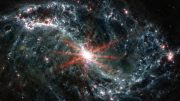
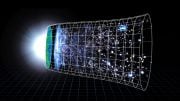
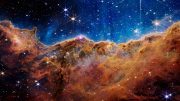

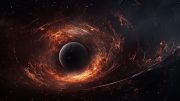
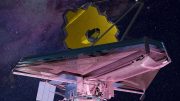
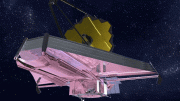
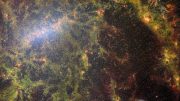
I need to martians like at the adx n the pentagon any suggestions